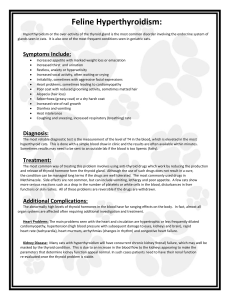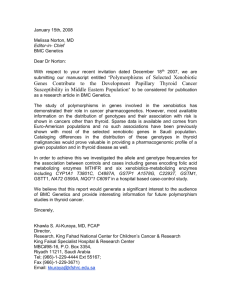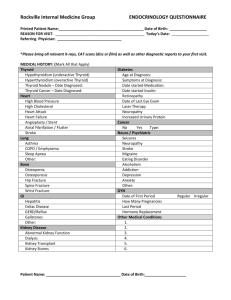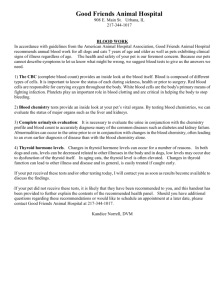Vol.3
advertisement
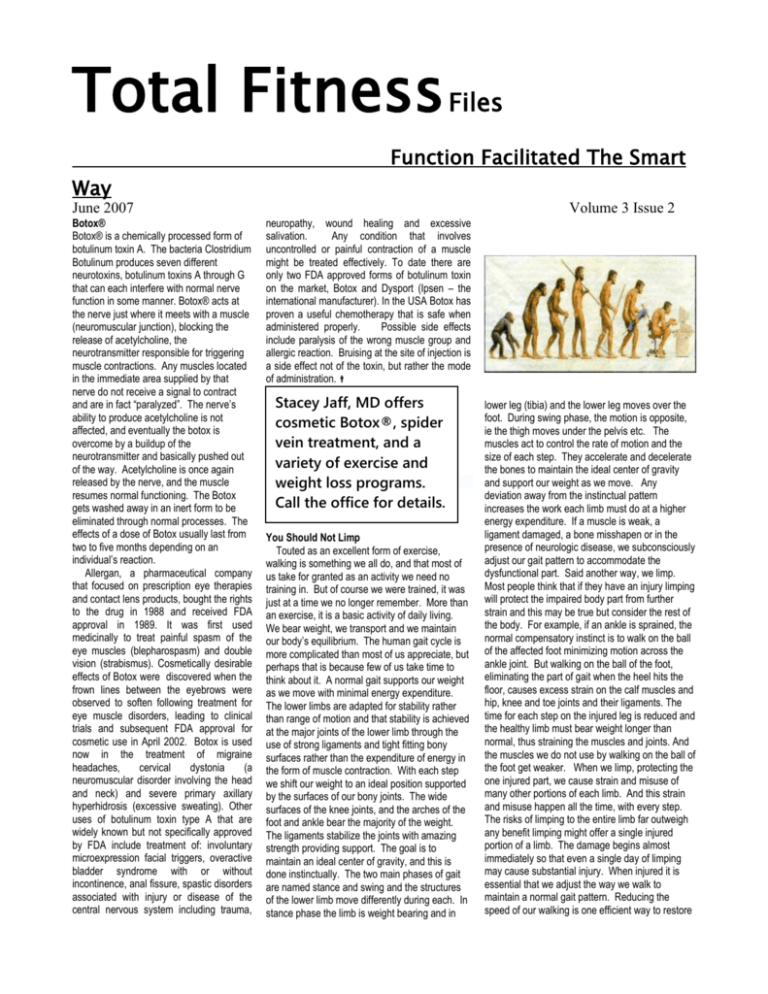
Total Fitness Files Function Facilitated The Smart Way June 2007 Botox® Botox® is a chemically processed form of botulinum toxin A. The bacteria Clostridium Botulinum produces seven different neurotoxins, botulinum toxins A through G that can each interfere with normal nerve function in some manner. Botox® acts at the nerve just where it meets with a muscle (neuromuscular junction), blocking the release of acetylcholine, the neurotransmitter responsible for triggering muscle contractions. Any muscles located in the immediate area supplied by that nerve do not receive a signal to contract and are in fact “paralyzed”. The nerve’s ability to produce acetylcholine is not affected, and eventually the botox is overcome by a buildup of the neurotransmitter and basically pushed out of the way. Acetylcholine is once again released by the nerve, and the muscle resumes normal functioning. The Botox gets washed away in an inert form to be eliminated through normal processes. The effects of a dose of Botox usually last from two to five months depending on an individual’s reaction. Allergan, a pharmaceutical company that focused on prescription eye therapies and contact lens products, bought the rights to the drug in 1988 and received FDA approval in 1989. It was first used medicinally to treat painful spasm of the eye muscles (blepharospasm) and double vision (strabismus). Cosmetically desirable effects of Botox were discovered when the frown lines between the eyebrows were observed to soften following treatment for eye muscle disorders, leading to clinical trials and subsequent FDA approval for cosmetic use in April 2002. Botox is used now in the treatment of migraine headaches, cervical dystonia (a neuromuscular disorder involving the head and neck) and severe primary axillary hyperhidrosis (excessive sweating). Other uses of botulinum toxin type A that are widely known but not specifically approved by FDA include treatment of: involuntary microexpression facial triggers, overactive bladder syndrome with or without incontinence, anal fissure, spastic disorders associated with injury or disease of the central nervous system including trauma, Volume 3 Issue 2 neuropathy, wound healing and excessive salivation. Any condition that involves uncontrolled or painful contraction of a muscle might be treated effectively. To date there are only two FDA approved forms of botulinum toxin on the market, Botox and Dysport (Ipsen – the international manufacturer). In the USA Botox has proven a useful chemotherapy that is safe when administered properly. Possible side effects include paralysis of the wrong muscle group and allergic reaction. Bruising at the site of injection is a side effect not of the toxin, but rather the mode of administration. Stacey Jaff, MD offers cosmetic Botox®, spider vein treatment, and a variety of exercise and weight loss programs. Call the office for details. You Should Not Limp Touted as an excellent form of exercise, walking is something we all do, and that most of us take for granted as an activity we need no training in. But of course we were trained, it was just at a time we no longer remember. More than an exercise, it is a basic activity of daily living. We bear weight, we transport and we maintain our body’s equilibrium. The human gait cycle is more complicated than most of us appreciate, but perhaps that is because few of us take time to think about it. A normal gait supports our weight as we move with minimal energy expenditure. The lower limbs are adapted for stability rather than range of motion and that stability is achieved at the major joints of the lower limb through the use of strong ligaments and tight fitting bony surfaces rather than the expenditure of energy in the form of muscle contraction. With each step we shift our weight to an ideal position supported by the surfaces of our bony joints. The wide surfaces of the knee joints, and the arches of the foot and ankle bear the majority of the weight. The ligaments stabilize the joints with amazing strength providing support. The goal is to maintain an ideal center of gravity, and this is done instinctually. The two main phases of gait are named stance and swing and the structures of the lower limb move differently during each. In stance phase the limb is weight bearing and in lower leg (tibia) and the lower leg moves over the foot. During swing phase, the motion is opposite, ie the thigh moves under the pelvis etc. The muscles act to control the rate of motion and the size of each step. They accelerate and decelerate the bones to maintain the ideal center of gravity and support our weight as we move. Any deviation away from the instinctual pattern increases the work each limb must do at a higher energy expenditure. If a muscle is weak, a ligament damaged, a bone misshapen or in the presence of neurologic disease, we subconsciously adjust our gait pattern to accommodate the dysfunctional part. Said another way, we limp. Most people think that if they have an injury limping will protect the impaired body part from further strain and this may be true but consider the rest of the body. For example, if an ankle is sprained, the normal compensatory instinct is to walk on the ball of the affected foot minimizing motion across the ankle joint. But walking on the ball of the foot, eliminating the part of gait when the heel hits the floor, causes excess strain on the calf muscles and hip, knee and toe joints and their ligaments. The time for each step on the injured leg is reduced and the healthy limb must bear weight longer than normal, thus straining the muscles and joints. And the muscles we do not use by walking on the ball of the foot get weaker. When we limp, protecting the one injured part, we cause strain and misuse of many other portions of each limb. And this strain and misuse happen all the time, with every step. The risks of limping to the entire limb far outweigh any benefit limping might offer a single injured portion of a limb. The damage begins almost immediately so that even a single day of limping may cause substantial injury. When injured it is essential that we adjust the way we walk to maintain a normal gait pattern. Reducing the speed of our walking is one efficient way to restore stroke, multiple sclerosis, Parkinson’s disease, or cerebral palsy, focal dystonias affecting the limbs, face, jaw, or vocal cords, TMJ pain disorders, diabetic swing phase the limb is non-weight bearing. During stance phase, the pelvis moves over the thigh (femur), the thigh moves over the The Thyroid The thyroid is a small gland, shaped like a butterfly, located in the lower part of your neck. The function of the gland is to secrete the hormones triiodothyronine (T3) and thyroxine (T4). Common problems that develop in the thyroid include: Hypothyroidism (underactive thyroid), Hyperthyroidism (overactive thyroid), Goiter (enlarged gland), Thyroiditis (inflammation of the gland), Thyroid Nodules (Lumps in the gland) and Thyroid Cancer. Common symptoms of hypothyroidism include fatigue, weight gain, constipation, fuzzy thinking, low blood pressure, fluid retention, depression, body pain, and slow reflexes. Common symptoms of hyperthyroidism include anxiety, insomnia, rapid weight loss, diarrhea, rapid heart rate, high blood pressure, eye sensitivity/bulging and vision disturbances. Abnormal growth of the gland as in goiter or with nodules may also affect swallowing, speech and voice quality and breathing. These are the most common but the list of possible symptoms of thyroid disease are vast and there are numerous other diseases associated with thyroid dysfunction. Skin and hair changes occur frequently and can be severe. Thyroid disease is often the result of autoimmune processes and these are associated with other auto-immune diseases such as celiac disease. During pregnancy thyroid function is affected by the hormones of pregnancy and thyroid hormone levels change as a result. There are increased incidences of carpal tunnel syndrome, fibromyalgia, osteoporosis, and adrenal and heart disease. The treatment of thyroid disease depends on many factors, including the type and severity of the thyroid disorder and the age and overall health of the patient. Treatment must be specific to each individual. Antithyroid drugs (also called thionamides) are used to treat an overactive thyroid. These drugs block the synthesis of thyroid hormone by the thyroid gland. Radioactive Iodine I-131 therapy is another treatment for an overactive thyroid. When a small dose of I-131 is swallowed, it is absorbed into the bloodstream in the gastrointestinal tract and concentrated from the blood by the thyroid gland, where it begins destroying the gland's cells. This treatment causes thyroid activity to slow considerably and in some cases, may turn an overactive thyroid into an underactive thyroid requiring additional treatment. With this and other forms of radioactive iodine the thyroid is tricked into absorbing the hormone replacement therapy involves synthetic T4 which works in the same way normal thyroid hormone would. Thyroid disease makes many physically uncomfortable. But the treatment of thyroid disease often mimics the disease producing similar symptoms. Fibromyalgia, myopathy, neuropathy and joint disease can be prevalent. Know the possible side effects of any medication or treatment you begin. Evaluate yourself and make note of new aches or abnormalities. Do not assume any changes in your physical being are normal due to aging, stress or fatigue. Understand what the goals of your treatment are and educate yourself about the disease and the drugs you take. FYI Sports Physical Therapy of New York has opened a new branch for comprehensive physical therapy services at 43 Central Park North 1B New York, NY 10026 Afriqiyah Woods, PT is now treating patients at this Harlem location. Dr. Jaff and Mrs. Woods have worked together for over 8 years successfully rehabilitating patients. The Elliptical The elliptical trainer acts like a different cardio machine at different stride (or incline) settings. At a low incline (a horizontal motion) the action is more like a NordicTrack cross-country skier; at medium settings it's similar to a bike (the typical elliptical movement); and at a high, more vertical incline it approximates a stair-climber. Choose a model with arm levers for total-body toning. a normal gait pattern. When this is not enough, using a cane or crutch to reduce our body weight can restore gait to normal. the motions. Get comfortable with adjusting the incline and level and you'll maximize your workout, using different muscles, and different metabolic pathways in one workout. After a brief warm-up at a low incline and low resistance, adjust the incline and resistance every 4-5 minutes. You can work for half an hour or longer. A sample program: 3 minutes warm up at low settings ( ie level 3 incline, level 2 resistance), 5 minutes at low-moderate settings (level 5 incline, level 4 resistance), 3 minutes at high settings (level 10 incline, level 10 resistance), 5 minutes at moderate settings (level 7 incline, level 8 resistance), 3 minutes pushing your max (level 15 incline, level 16 resistance), 5 minutes at moderate settings (level 7 incline, level 8 resistance), 3 minutes at low-moderate settings (level 5 incline, level 4 resistance) and finish with 2 minutes level 3 incline, level 2 resistance. You should burn about 300 calories in 30 minutes (depending on your starting weight). You can repeat this program for a longer workout, or design your own. Try a routine of gradually increasing the level and resistance by 2 levels every 3-5 minutes, and then decreasing by the same intervals, or keep the level of incline and resistance constant for the entire workout but vary your speed. In this way you maximize what the elliptical machine can offer. Stacey Jaff, MD will offer weekend workshops in exercise instruction. Each participant will undergo a comprehensive fitness assessment and receive a unique exercise program designed for their individual goals. Inquire at the office. Stacey Jaff, MD Board Certified Physiatrist Address all Correspondence to: 382 Central Park West #20V New York, NY 10025 Telephone (212) 222-1007 Fax (212) 722-7687 Office Address: 43 Central Park North 1B New York, NY 10026 Monday through Friday 8AM – 7:30PM radioavtive iodine which destroys the thyroid cells. Thyroid When you use your upper and lower body at the same time--like you do on an elliptical with arm levers--your core has to work hard to coordinate


